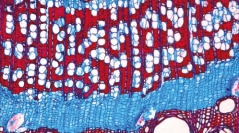

 Adansonia
45 (12) - Pages 167-210
Adansonia
45 (12) - Pages 167-210Species with lianescent habit account for half of the diversity of Bignoniaceae. Recent molecular phylogenetic studies have provided the basis for new circumscriptions of entire liana lineages within tribes Bignonieae and Tecomeae s.s., where only monophyletic taxa are recognized. However, some clades remain without good morphological synapomorphies. In search of features of taxonomic potential, we collected, sectioned, and analyzed the bark of 83 lianescent species of the Bignoniaceae, covering all 20 genera from tribe Bignonieae currently recognized, plus three of the most widely cultivated lianas of Tecomeae s.s. Detailed bark descriptions are given to major lineages within both tribes, following their most recent phylogenetic hypotheses and classifications. Our anatomical studies allowed us to identify 19 potential synapomorphies for large clades or specific genera of lianas, such as the fibrous phloem found in members of the Fridericia Mart. emend L.G.Lohmann and allies clade, the exclusive presence of sclereids in the regular phloem of Pleonotoma Miers, and the presence of radially elongated fibers in Manaosella J.C.Gomes, among others. Using a combination of features, we were able to produce the first bark key to identify genera of lianescent Bignoniaceae. Our work reinforces the importance of bark features for a deeper understanding of taxonomic and phylogenetic relationships among taxa.
Bignoniaceae, lignification, limiting ray, periderm, phloem companion cells, phloem fibers, phloem sclereids, phloem wedges, variant phloem